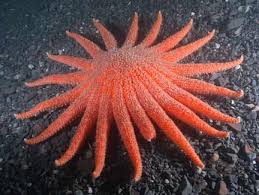(单词翻译:单击)
听力文本
Millions of invertebrates invade the seabed.
百万只无脊椎动物侵袭了海床。
The most fearsome predator here is a giant.
这里有可怕的大型掠食动物。
The sunflower starfish is a meter across, with an appetite for brittle stars.
向日葵海星长达1米,它喜欢吃蛇尾海星。
It uses it's feet to taste for prey.
向日葵海星用触角来试探猎物。
When it's actions are speeded up,
在快速镜头下,
it becomes clear that the predator's fondness for the brittle stars
可以清楚看到向日葵海星喜欢吃蛇尾海星,
is almost matched by the brittle stars ability to get out of the way.
这与蛇尾海星快速逃离现场也是相吻合的。

Sand dollars flat sea urchins cluster together as a defense
成群的饼海胆叠加起来组成防御阵线。
But it doesn't seem to work against the sunflower starfish.
不过好像在向日葵海星面前没有作用。
The predator extrudes it's stomach, and wraps it around it's victims liquefying their soft parts.
向日葵海星挤出它的胃,包住饼海胆直接消化其软组织。
Nothing is left of them, except their white skeletons.
最后只剩下饼海胆的白色骨架。
视频及简介
这里有在印度尼西亚珊瑚海最新发现的矮小海马,闪着“电”光的蛤蜊和一丛丛的剧毒海蛇。这里还有海胆掉进巨海藻丛林,以及巨大的牛皮海狮捕食南非国王企鹅的场面。而这些企鹅不顾它们在体重上的劣势,拿出勇气与之海狮争斗的场景着实精彩。


